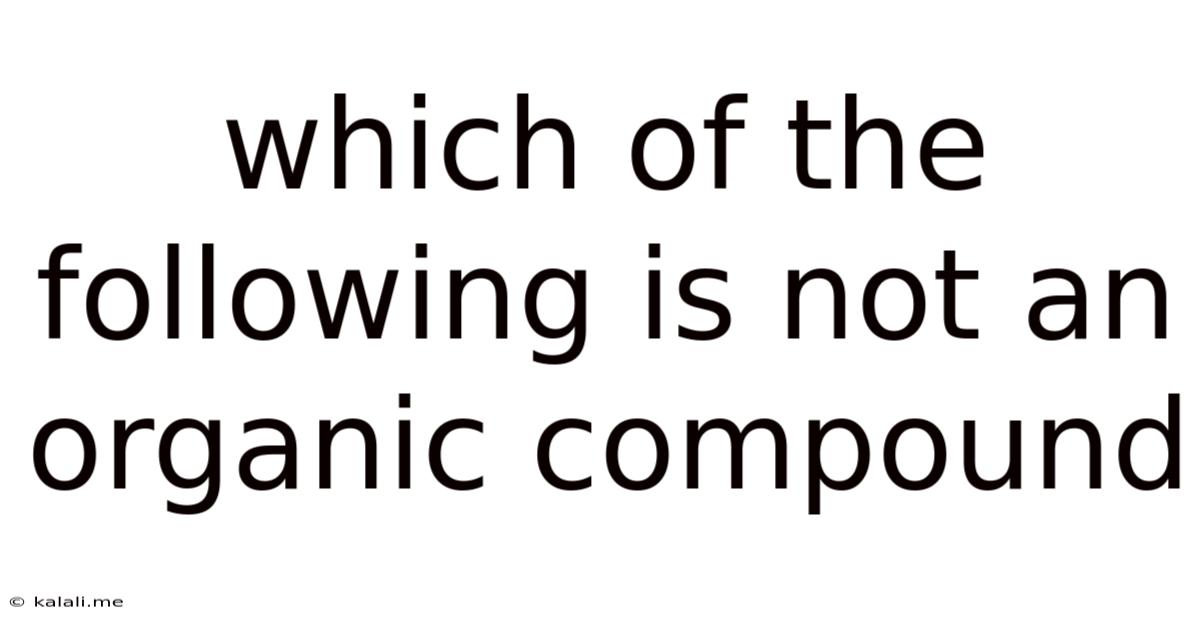Which Of The Following Is Not An Organic Compound
Kalali
Jun 13, 2025 · 2 min read

Table of Contents
Which of the Following is Not an Organic Compound? Demystifying Organic Chemistry
Organic chemistry can seem daunting, but understanding its core principles is surprisingly straightforward. This article will explore the fundamental definition of organic compounds and help you identify which of a given list might not belong. We'll delve into the characteristics of organic molecules and explore common exceptions.
What are Organic Compounds?
The simple answer is that organic compounds are chemical compounds containing carbon atoms bonded to hydrogen atoms. This seemingly straightforward definition has historical roots, stemming from the early belief that organic compounds could only be produced by living organisms. While this isn't strictly true today, the presence of a carbon-hydrogen bond (C-H) remains a crucial element in classifying most organic compounds.
Exceptions to the Rule: Inorganic Compounds within the Carbon Family
While carbon forms the backbone of most organic molecules, several exceptions exist. These exceptions are generally considered inorganic compounds, even though they contain carbon. Here are some key examples:
- Carbon Dioxide (CO2): Despite containing carbon, CO2 lacks the characteristic C-H bond and is considered an inorganic compound. It's a crucial component of Earth's atmosphere and plays a vital role in the carbon cycle.
- Carbon Monoxide (CO): Similar to CO2, carbon monoxide lacks the C-H bond and is classified as inorganic. It is a highly toxic gas.
- Carbides: These are compounds composed of carbon and a metal or metalloid. Examples include calcium carbide (CaC2) and silicon carbide (SiC). Their bonding characteristics differ significantly from typical organic molecules.
- Carbonates: These compounds contain the carbonate ion (CO3 2-), such as calcium carbonate (CaCO3), the main component of limestone. Their structure and properties differ considerably from most organic materials.
- Cyanides: Cyanides contain the cyanide ion (CN-), such as potassium cyanide (KCN). They are highly toxic and are generally considered inorganic.
Identifying Non-Organic Compounds: A Practical Approach
When faced with a multiple-choice question or a list of compounds, look for these key indicators:
- Absence of C-H bonds: The most crucial factor. If a compound lacks a direct carbon-hydrogen bond, it's highly likely to be inorganic.
- Presence of solely carbon-oxygen bonds: Compounds primarily composed of carbon and oxygen bonds (excluding those mentioned above) could be considered inorganic, such as carbon dioxide and carbonates.
- Presence of carbon bonded to metals or metalloids: Carbides are classic examples.
- Presence of cyanide groups: Cyanide-containing compounds are generally inorganic.
Conclusion:
The line between organic and inorganic chemistry can be blurry, but understanding the core principles of organic chemistry — particularly the significance of the C-H bond — provides a solid foundation for classifying compounds. Remembering the exceptions highlighted above, such as carbon dioxide, carbon monoxide, carbides, carbonates, and cyanides, will significantly enhance your ability to correctly identify non-organic compounds. Always focus on the key characteristics of the chemical bonds present in the molecule in question to make the accurate classification.
Latest Posts
Latest Posts
-
How Many Babies Were Conceived At Woodstock 1969
Jul 01, 2025
-
How Many Feet Is In 40 Yards
Jul 01, 2025
-
Least Common Denominator Of 9 And 7
Jul 01, 2025
-
How Many Feet In A Mile And A Half
Jul 01, 2025
-
11am To 9pm Is How Many Hours
Jul 01, 2025
Related Post
Thank you for visiting our website which covers about Which Of The Following Is Not An Organic Compound . We hope the information provided has been useful to you. Feel free to contact us if you have any questions or need further assistance. See you next time and don't miss to bookmark.